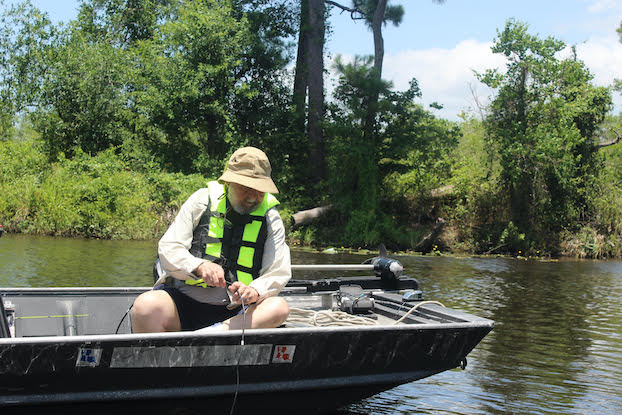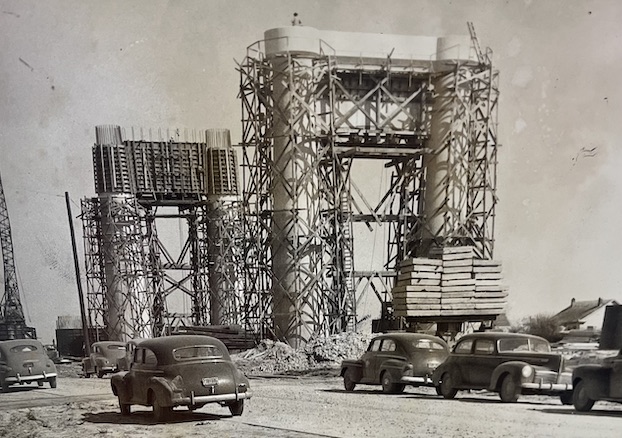Environmentalists hoping to bring attention to possible contamination in Westlake
Published 8:44 am Wednesday, June 21, 2023

- Michael Tritico of RESTORE checks water temperatures at Little River. (Emily Burleigh / American Press)
Local environmentalists hope to bring government and public attention to potential contamination in Little River in Westlake.
To do so, Michael Tritico, a member of RESTORE, tested water temperatures near and at what he believes to be a poisoned spring in Little River on Friday.
This action stemmed from concerns that were raised at a public meeting in May that was held by representatives from Cecos International and Geosyntec Consultant. At the meeting, the revised Groundwater Sampling and Analysis Plan for Willow Spring — a previous hazardous chemical waste site that is currently in post-closure — was presented to the public.
Trending
During the meeting, Tritico said more areas need to be tested. Four hundred feet away from the northeastern corner of the site, there is a possible position spring, he said. “There is a data gap between the facility and Little River — which has been the thrust of RESTORE’s efforts — to get borings and analyses to determine whether or not the shallow pervious zone is feeding a spring into Little River and, if so, are hazardous wastes in that spring.”
For the last 40 years, he and others have attempted to get this area tested for contaminants.
The northeastern corner holds the shallow pervious zone – an area with shallow sand. He said that sand is “a conduit of easy migration of groundwater back and forth, as well as toxic materials.”
Cecos monitors contaminant levels in the groundwater of where the waste disposal site used to be with monitoring and recovery wells. In the northeastern corner, there are multiple wells that test the shallow zone and the 50-foot zone.
But Tritico said there is a “stair-step kind of arrangement of hazardous waste pits” traveling down the hill located near the facility into the northeast corner.
He said he is a firsthand witness of how the pits would drain out of monitoring boundaries during rainstorms – under the fence, through Henagan Swamp and into Little River.
Trending
He also recalled seeing dying cypress and tupelo trees in the area, and a man that chemically burned his leg in the Henagan Swamp mud.
Water temperature testing was needed to determine whether or not groundwater from Little River was entering main waterways. If the temperatures at the bottom of the river bed are noticeably lower than surface level temperatures, that is an indication of cold groundwater flow, he said.
He tested both surface and bottom temperatures upstream and downstream of the possible poison spring. The upstream surface temperature was 94.1 degrees and the downstream surface temperature was 91.4. The bottom temperature for both those areas was 87.8 degrees.
At the hypothesized site of the poisoned spring, the surface temperature was 92.48 degrees and the bottom temperature was 80.42 degrees. Not only is this about 7 degrees colder than the other tested areas, there is a difference of 12.06 degrees between the surface and bottom temperatures.
For Tritico, the drop in temperature at the possible poison spring is proof the groundwater runs into Little River. This, however, is not adequate data to deny or prove claims of contamination. That responsibility would be given to Cecos.
He hopes this is a first step to get Cecos and the Louisiana Department of Environmental Quality to look into the possible contamination.
This is an action he has been waiting to see. Tritico cited a consent decree from 1989 that was a result of a civil action case that Cecos was involved in. Section 5 of attachment A states: “The defendants shall define the complete extent of groundwater contamination of the ‘shallow sand’ in the vicinity of the northeast corner of the facility.”
It is the belief of local environmentalists that this requirement wasn’t fulfilled, as the shallow sand between the northeast corner and Little River is not tested.
The plan that Cecos presented at the May meeting states that the shallow pervious zone only occurs in the northeastern portion of the facility near Little River, which is within their monitoring area.
“That is an example of the company relying on a lack of data between the northeastern portion of the facility and the Little River as a way to try to limit the true extent of the shallow pervious zone to just within its fence line,” Tritico said.
Tritico became involved with the cause while hosting a radio show on two Sulphur stations during the 1970s. He began researching Willow Springs after receiving a call from Ruth Shepard, who said that there were poison pits making citizens and livestock sick. “I went up there and realized it was a disaster and would be forever.”
He made it a life’s mission to bring awareness to the problem. “ I did what the Creator put me here to do, which is to use my mind, training, and experience to point out the need for restoration of what he had provided for us because he had things right.”
Tritico has a bachelor’s degree in Biology from McNeese State University, and conducted graduate studies at LSU, San Francisco State University, Fresno State University and the University of Hawaii.
He has firsthand and hands-on experience with Willow Springs. He participated in field mentorships at the site on geohydrology under Dr. Paul Hastings Jones and Dr. William Gill Smith with the LSU Marine Science Department. In addition, he has U.S. Park Ranger and Naturalist training and work experience that he conducted in Glacier Park, Montana and Yosemite Park and cross-examined company experts during official intervention in state adjudicatory hearings.
Getting out on the water Friday afternoon to test temperatures was a full-circle moment for him. “This to me, fulfills a promise I made to stay with it, no matter what, and I have for close to 50 years,” he said. “I think that’s what it takes when people have a serious problem and it’s not resolved by the proper authorities… To me, that’s one of the important things we did today. It proves the citizens are going to stick to it no matter what.”




